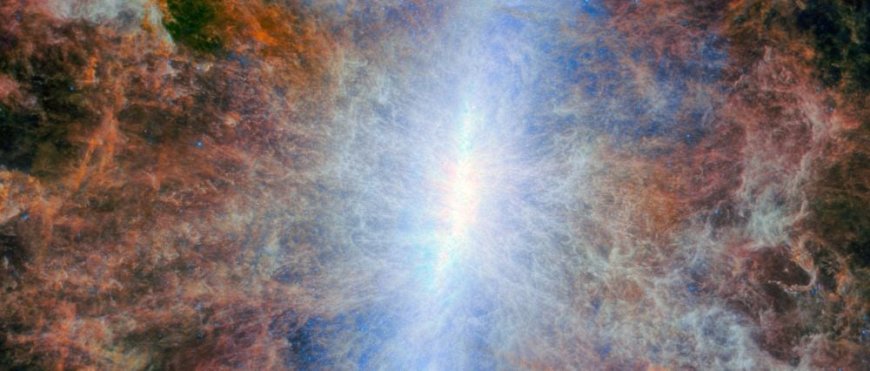Exploring a Bright Star-Making Galaxy with the JWST
Starburst galaxies like the Cigar Galaxy (M82) are known for their intense star formation, creating superclusters with thousands of stars each year. The JWST captured stunning images of M82, revealing its unique features and interactions with its neighbor M81. Astronomers study these galaxies to understand the dynamics of star formation and galaxy evolution.

When it comes to star formation, not all galaxies are the same. Some are quenched, meaning they've depleted their star forming gas and form very few new stars. Some, like the Milky Way, are typical and form stars at an average rate. But some are extremely active, and form stars so readily they're called starburst galaxies.
Starburst galaxies experience episodes of pronounced star formation, where stellar superclusters containing 100,000 stars or more are born in the hundreds. These galaxies can form hundreds or even thousands of solar masses in stars each year. As a result, they're extremely luminous, and can be brighter than the Sun by trillions of times in the infrared.
The Cigar Galaxy (M82) is one of these starburst galaxies, and while its extreme luminosity is not apparent in optical light due to dust, the JWST can easily observe the galaxy's abundant star formation in infrared.
The JWST captured this image of M82 in shorter wavelengths with its NIRCam instrument. Some of the bright point sources are super star clusters that can contain 100,000 stars, and the Hubble identified about 200 of them in the galaxy. Astronomers use data in images like this to determine the galaxy's star formation rate. Image Credit: NASA, ESA, CSA, STScI, A. Bolatto (UMD)
Superclusters in M82 are responsible for much of the galaxy's heightened luminosity. With around 100,000 stars, some of them have more stars than some globular clusters do.
This image from a 2024 paper shows some of the superclusters in M82. Image Credit: Levy et al. 2024. ApJ. DOI 10.3847/2041-8213/ad7af3
Galaxies need abundant gas to become starburst galaxies, and M82 likely got an injection of gas by interacting gravitationally with its neighbor M81. The pair are orbiting one another about once every 100 million years. Those interactions have deformed M82 into its elongated cigar shape, and also sent gas from M82's outer regions into its core, fueling its abundant star formation.
M81 (left) and M82 (right) interact gravitationally and orbit one another once every 100 million years or so. The interactions have stretched the smaller M82 into a cigar shape, giving it the nickname the Cigar Galaxy. The interactions are also triggering starburst episodes, evidenced by the filaments of red hydrogen gas. Image Credit: T.A. Rector (University of Alaska Anchorage) and NOIRLab/NSF/AURA/
Astronomers are interested in M82 and its neighbor because they're like a laboratory for watching galaxy interactions. A 2024 paper used polycyclic aromatic hydrocarbon (PAH) emissions to reveal an intricate web of filaments and bubbles of gas created by supernovae. They also revealed M82's galactic outflow. These outflows are another prominent feature of starburst galaxies.
The leading JWST image also traces PAHs and they show the galactic outflows. They're visible as elongated bright streaks emanating from the galactic center. PAHs are important in astronomy because they have strong emission features in the mid-infrared. They're strongly correlated with cold molecular gas and help trace the movement of the gas.
The leading JWST image clearly shows the galactic outflow winds from the galaxy's center. They're driven by the abundant formation of massive stars, and by supernova explosions. Image Credit: ESA/Webb, NASA & CSA, A. Bolatto. License: CC BY 4.0 INT
The outflows are created by the galaxy's abundant star formation. The starburst activity produces thousands of stars much hotter and more massive than our Sun. These stars generate powerful stellar winds that drive gas away. Many of these stars will explode as supernovae, which also drives gas away. For these reasons, starburst galaxies don't experience extreme star formation for much longer than about 100 million years before their gas supply is dissipated.
However, M82 might be different. Due to repeated gravitational interactions with M81 in the future, M82 may go through cycles of abundant star formation and quenching. Astronomers think this has happened in the past. About 600 million years ago, it underwent a starburst phase, and the current phase was likely triggered between about 30 and 60 million years ago.
M82 is only about 12 million light-years away, close for a galaxy. As a result, astronomers have focused a lot of attention on the starburst galaxy. It has been imaged repeatedly by the Hubble and other telescopes.
Hubble captured this brilliant image of M82 that highlights the filaments of wind-borne gas in red. Image Credit: NASA, ESA and the Hubble Heritage Team (STScI/AURA); Acknowledgment: J. Gallagher (University of Wisconsin), M. Mountain (STScI) and P. Puxley (National Science Foundation)
M82 will undergo many more starburst cycles in its future. But eventually, M82 and M81 will merge into one galaxy. That merger, in the far distant future, will likely trigger one massive, chaotic starburst event. Eventually that, too, will die down, and the resulting massive galaxy will settle into a quiet state.
What's Your Reaction?
 Like
0
Like
0
 Dislike
0
Dislike
0
 Love
0
Love
0
 Funny
0
Funny
0
 Angry
0
Angry
0
 Sad
0
Sad
0
 Wow
0
Wow
0






































































































































































